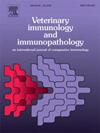Temporal changes in biomarkers of oxidative stress and inflammation in pigs after intravenous administration of E. coli lipopolysaccharide
IF 1.4
3区 农林科学
Q4 IMMUNOLOGY
引用次数: 0
Abstract
Enterotoxigenic E. coli infection is a major cause of post-weaning diarrhea in pigs and is associated with systemic inflammation and oxidative stress. This study aimed to characterize temporal changes in biomarkers of inflammation and oxidative stress in response to an E. coli lipopolysaccharide (LPS) challenge, providing insights into host immune responses. Ten female pigs (27.9 kg BW; ∼3 months old) were infused with LPS derived from E. coli O111:B4 at LOW (0.75 µg LPS/kg BW) or MODERATE (1.50 µg LPS/kg BW) dosages. Thirteen blood samples were collected via venous catheter at 0 (pre-infusion), and from 0.5 to 72 h post LPS infusion. Rectal temperature, blood cytokines, acute-phase proteins, and oxidative stress markers were measured. A semi-targeted metabolomics approach was applied to investigate oxidative stress markers, including 8-iso-prostaglandin F₂α (8-iso-PGF₂α). Rectal temperature peaked at 3 h and returned to pre-infusion levels by 8 h. Plasma C-reactive protein (CRP) peaked at 12 h, while haptoglobin peaked at 24 h after LPS infusion. Pig major acute-phase protein (Pig-MAP) peaked at 24 h (LOW) and 36 h (MODERATE). Malondialdehyde (MDA) peaked between 0.5 and 1 h and returned to pre-infusion levels within 12 h. The cytokines IL-6, IFN-γ, IL-10 and IL-1β peaked between 1 and 3 h post-infusion. Moreover, cortisol increased rapidly, peaking at 2 h post LPS infusion. These findings indicate distinct temporal responses of inflammatory and oxidative stress markers following LPS challenge, supporting their use as potential biomarkers for evaluating interventions modulating infection-induced oxidative stress in pigs.
静脉注射大肠杆菌脂多糖后猪氧化应激和炎症生物标志物的时间变化。
产肠毒素大肠杆菌感染是猪断奶后腹泻的主要原因,并与全身炎症和氧化应激有关。本研究旨在表征炎症和氧化应激生物标志物在响应大肠杆菌脂多糖(LPS)挑战时的时间变化,为宿主免疫反应提供见解。10头母猪(27.9 kg BW, ~ 3月龄)以低剂量(0.75 µg LPS/kg BW)或中等剂量(1.50 µg LPS/kg BW)注射大肠杆菌O111:B4衍生的LPS。分别于0(注射前)和0.5 ~ 72 h(注射LPS后)通过静脉导管采集血样13份。测量直肠温度、血液细胞因子、急性期蛋白和氧化应激标志物。采用半靶向代谢组学方法研究氧化应激标志物,包括8-iso-前列腺素F₂α (8-iso-PGF₂α)。直肠温度在3 h时达到峰值,在8 h时恢复到注射前水平。血浆c反应蛋白(CRP)在12 h达到峰值,而接触珠蛋白在24 h达到峰值。猪主要急性期蛋白(Pig- map)在24 h (LOW)和36 h (MODERATE)达到峰值。丙二醛(MDA)在0.5 ~ 1 h之间达到峰值,并在12 h内恢复到注射前水平。细胞因子IL-6、IFN-γ、IL-10和IL-1β在注射后1 ~ 3 h达到峰值。此外,皮质醇迅速升高,在2 h时达到峰值。这些发现表明,LPS刺激后炎症和氧化应激标志物的时间反应不同,支持它们作为评估干预措施调节猪感染诱导的氧化应激的潜在生物标志物。
本文章由计算机程序翻译,如有差异,请以英文原文为准。
求助全文
约1分钟内获得全文
求助全文
来源期刊
CiteScore
3.40
自引率
5.60%
发文量
79
审稿时长
70 days
期刊介绍:
The journal reports basic, comparative and clinical immunology as they pertain to the animal species designated here: livestock, poultry, and fish species that are major food animals and companion animals such as cats, dogs, horses and camels, and wildlife species that act as reservoirs for food, companion or human infectious diseases, or as models for human disease.
Rodent models of infectious diseases that are of importance in the animal species indicated above,when the disease requires a level of containment that is not readily available for larger animal experimentation (ABSL3), will be considered. Papers on rabbits, lizards, guinea pigs, badgers, armadillos, elephants, antelope, and buffalo will be reviewed if the research advances our fundamental understanding of immunology, or if they act as a reservoir of infectious disease for the primary animal species designated above, or for humans. Manuscripts employing other species will be reviewed if justified as fitting into the categories above.
The following topics are appropriate: biology of cells and mechanisms of the immune system, immunochemistry, immunodeficiencies, immunodiagnosis, immunogenetics, immunopathology, immunology of infectious disease and tumors, immunoprophylaxis including vaccine development and delivery, immunological aspects of pregnancy including passive immunity, autoimmuity, neuroimmunology, and transplanatation immunology. Manuscripts that describe new genes and development of tools such as monoclonal antibodies are also of interest when part of a larger biological study. Studies employing extracts or constituents (plant extracts, feed additives or microbiome) must be sufficiently defined to be reproduced in other laboratories and also provide evidence for possible mechanisms and not simply show an effect on the immune system.

 求助内容:
求助内容: 应助结果提醒方式:
应助结果提醒方式:


